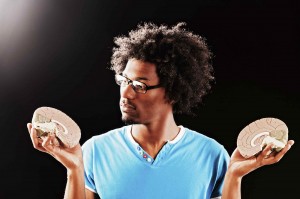Two Brains. So What?

Alas, poor System 1…
We have two different thinking systems in our brain, often called System 1 and System 2. System 1 is fast and automatic and makes up to 95% of our decisions. System 2 is a slow energy hog that allows us to think through issues consciously. When we think of thinking, we’re thinking of System 2.
You might ask: Why would this matter to anyone other than neuroscientists? It’s interesting to know but does it have any practical impact? Well, here are some things that we might want to change based on the dual-brain idea.
Economic theory – our classic economic theories depend on the notion of rational people making rational decisions. As Daniel Kahneman points out, that’s not the way the world works. For instance, our loss aversion bias pushes us towards non-rational investment decisions. (See also here). It happens all the time and has created a whole new school of thought called behavioral economics (and a Nobel prize for Kahneman).
Intelligence testing – System 1 makes up to 95% of our decisions but our classic IQ tests focus exclusively on System 2. That doesn’t make sense. We need new tests that incorporate rationality as well as intelligence.
Advertising – we often measure the effectiveness of advertising through awareness tests. Yet System 1 operates below the threshold of awareness. We can know things without knowing that we know them. As Peter Steidl points out, if we make 95% of our decisions in System 1, doesn’t it also follow that we make (roughly) 95% of our purchase decisions in System 1? Branding should focus on our habits and memory rather than our awareness.
Habits (both good and bad) – we know that we shouldn’t procrastinate (or smoke or eat too much, etc.). We know that in System 2, our conscious self. But System 2 doesn’t control our habits; System 1 does. In fact, John Arden calls System 1 the habitual brain. If we want to change our bad habits (or reinforce our goods ones), we need to change the habits and rules stored in System 1. How do we do that? Largely by changing our memories.
Judgment, probability, and public policy – As Daniel Kahneman points out, humans are naturally good at grammar but awful at statistics. We create our mental models in System 1, not System 2. How frequently does something happen? We estimate probability based on how easy it is to retrieve memories. What kinds of memories are easy to retrieve? Any memory that’s especially vivid or scary. Thus, we overestimate the probability of violent crime and underestimate the probability of good deeds. We make policy decisions and public investments based on erroneous – but deeply held – predictions.
Less logic, louder voice – people who aren’t very good at something tend to overestimate their skills. It’s the Dunning-Kruger effect – people don’t recognize their own ineptitude. It’s an artifact of System 1. Experts will often craft their conclusions very carefully with many caveats and warnings. Non-experts don’t know that their expertise is limited; they simply assume that they’re right. Thus, they often speak more loudly. It’s the old saying: “He’s seldom right but never in doubt”.
Teaching critical thinking – I’ve read nearly two-dozen textbooks on critical thinking. None of them give more than a passing remark or two on the essential differences between System 1 and System 2. They focus exclusively on our conscious selves: System 2. In other words, they focus on how we make five per cent of our decisions. It’s time to re-think the way we teach thinking.
Neurobranding – 1

Why did I buy it? Who knows?
I wrote recently about the unsettling experience of forgetting my PIN while at an ATM at the Denver airport. My mind went blank; for the life of me, I couldn’t remember the number.
As I walked away from the machine, the number popped into my head: 2061. I was sure it was the right number, so I returned to the machine and entered it. Wrong. I transposed some of the digits. Wrong again. Finally, I gave up. As I walked away again, I noticed that I was standing by a door with a number on it: 2061.
My System 1 had noticed the number but didn’t bother to send it to System 2. But when my System 2 broadcast an emergency message, looking for a four-digit number, System 1 offered up the most recent one it had seen. The number just popped into my head. (For more on Systems 1 and 2, click here).
To recap: information entered my brain via System 1 without my being consciously aware of it and I took action based on it.
So here’s a question: could advertisers use similar techniques to plant information in my brain without my knowing it and induce me to take action on it … by buying something?
The short answer: of course they could. In fact, they probably already have. That, at least, is the theory put forth by Peter Steidl in his book, Neurobranding.
Steidl starts by considering what he calls the habitual brain (System 1) and the considering brain (System 2). System 1 makes the vast majority of our decisions – and does so on its own without bothering to send a memo to our conscious self (System 2). Steidl points out that System 1 make a vast majority of our purchase decisions as well.
Broadly speaking, System 1 works by comparing new events to past memories. If a new event corresponds to a happy memory, then we’ll probably feel happy, even if we don’t consciously understand why. If the event evokes scary memories, then we become wary. Did you ever have an uneasy feeling about something? Your System 1 is trying to tell you something. It’s not a bad idea to pay attention.
Steidl also points out that the purpose of branding is to create memories. In fact, it’s a three-step process. First, we create a memory. If we can create a memory that corresponds to a happy memory already stored in the habitual brain, so much the better. Second, we shape the memory, using a variety of signs and symbols. Finally, we activate the memory to keep it from fading away.
All this can happen blow the level of consciousness. Indeed, Steidl argues that most consumers really don’t know why they buy most products. If you ask them, they’ll make up an answer in a process known as confabulation. A confabulated answer has nothing to do with reality, which is why market research is so often wrong. You ask a consumer a question. The consumer confabulates. You believe her. You’re in big trouble.
If all this happens below the threshold of consciousness, why do we bother with awareness research? Steidl argues that awareness and attribute research are essentially useless. Consumers may be aware of many brands but they’re not aware that they’re aware.
Let’s go back to the ATM example – and assume that you interview me before I realized where the number 2061 came from. If you had asked me, “What’s the number on the door you’re standing by?”, I would have answered, “I have no earthly idea.” I didn’t know that my System 1 had picked up the number. I didn’t know that I knew.
So, how do you plant memories in someone’s System 1? It’s not easy but it can be done. I’ll return to this in an upcoming article.